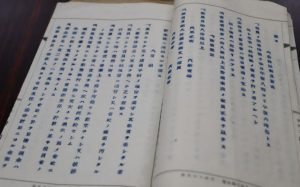“Work regulations” for Taishoya Kimono Shop, predecessor to Rest House, showing work styles before A-bombing to be donated to Hiroshima City by shop manager’s family
Jul. 31, 2024
by Michio Shimotaka, Staff Writer
The Taishoya Kimono Shop’s “work regulations” document is to be donated to the Hiroshima City government. The shop was the predecessor to what is now known as the Rest House, an A-bombed building located in Peace Memorial Park in Hiroshima’s Naka Ward. The document of regulations was left behind by the late Kinjiro Wakasa, who worked as manager of the shop’s sales and general affairs department until it closed in 1943. Members of Mr. Wakasa’s surviving family have held on to the document. Describing it as an important material showing the work styles of people in the pre-war period, Hiroshima City will display the document at the Rest House during the period August 1–13.
The regulations are made up of six pages of paper measuring 24 centimeters in length and 17 centimeters in width, tied together by twisted strings of paper. It is not clear when the regulations were enacted, but job title, monthly salary, and work hours of the shop employees are outlined in detail in the document. Yukimi Dohi, a curator at the Hiroshima Peace Memorial Museum in the city’s Naka Ward, said, “It is valuable material that reveals the organization’s structure and the work styles of employees.” Because wage differences depending on employee gender or educational level are indicated in the document, Ms. Dohi said, “It gives insight into one part of the social structure at that time.”
Taishoya Kimono Shop began operations in 1912 and in 1929 built a new shop building, which would later become the Rest House. The shop closed in 1943 during the Pacific theater of World War II due to a government order designed to control the textile industry. Mr. Wakasa held on to the shop’s regulations at his home in Hiroshima’s Naka Ward. Toshiyasu Wakasa, 68, Kinjiro’s grandson and manager of a kimono shop located in the same Naka Ward, decided to donate the regulations to the city government, based on his hope that “visitors become aware of the fact that people had once lived ordinary lives in today’s Peace Memorial Park.”
After showing it to the public, the city will store the original document at the Hiroshima Municipal Archive. It plans to make a replica of the document and later put it on display at the Rest House.
(Originally published on July 31, 2024)
The Taishoya Kimono Shop’s “work regulations” document is to be donated to the Hiroshima City government. The shop was the predecessor to what is now known as the Rest House, an A-bombed building located in Peace Memorial Park in Hiroshima’s Naka Ward. The document of regulations was left behind by the late Kinjiro Wakasa, who worked as manager of the shop’s sales and general affairs department until it closed in 1943. Members of Mr. Wakasa’s surviving family have held on to the document. Describing it as an important material showing the work styles of people in the pre-war period, Hiroshima City will display the document at the Rest House during the period August 1–13.
The regulations are made up of six pages of paper measuring 24 centimeters in length and 17 centimeters in width, tied together by twisted strings of paper. It is not clear when the regulations were enacted, but job title, monthly salary, and work hours of the shop employees are outlined in detail in the document. Yukimi Dohi, a curator at the Hiroshima Peace Memorial Museum in the city’s Naka Ward, said, “It is valuable material that reveals the organization’s structure and the work styles of employees.” Because wage differences depending on employee gender or educational level are indicated in the document, Ms. Dohi said, “It gives insight into one part of the social structure at that time.”
Taishoya Kimono Shop began operations in 1912 and in 1929 built a new shop building, which would later become the Rest House. The shop closed in 1943 during the Pacific theater of World War II due to a government order designed to control the textile industry. Mr. Wakasa held on to the shop’s regulations at his home in Hiroshima’s Naka Ward. Toshiyasu Wakasa, 68, Kinjiro’s grandson and manager of a kimono shop located in the same Naka Ward, decided to donate the regulations to the city government, based on his hope that “visitors become aware of the fact that people had once lived ordinary lives in today’s Peace Memorial Park.”
After showing it to the public, the city will store the original document at the Hiroshima Municipal Archive. It plans to make a replica of the document and later put it on display at the Rest House.
(Originally published on July 31, 2024)









